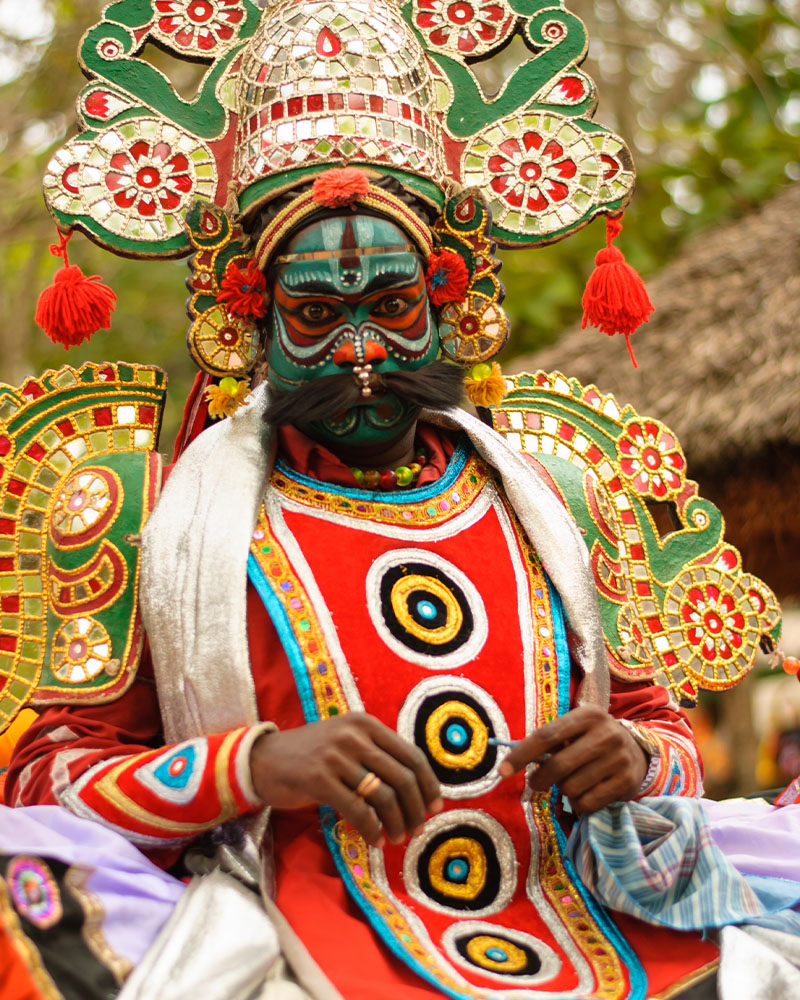A form of folk theatre from Tamil Nadu also known as kattaikkuttu and koothu, therukoothu performances include elements of traditional theatre, song, dance and ritual.
Therukoothu is believed to have evolved from early Dravida performance styles that were the ancestors of other traditional performances such as Kathakali, Yakshagana, Theyyam, Bhuta, and Mudiyettu. The Silappatikaram, an epic Tamil poem from the Sangam period, mentions eleven different types of theatre that may have been related to these early styles. Scholars have suggested that these performances also influenced each other as they evolved, pointing to similarities in makeup, musical structure, and the ritual elements employed.
Therukoothu narratives are often based on Tamil iterations of the Mahabharatha, and it is also employed in mother goddess worship in the region. Draupadi is therefore one of the most important figures in therukoothu performances, worshipped as a deity known as Draupadi Amman (Mother Draupadi). Some Mahabharatha episodes that are often depicted in therukoothu include the Draupadi Vastropaharanam or the disrobing of Draupadi and the Pakatai Tuyil or the Dice Game. These episodes are typically performed over ten to eighteen days following the harvest in rural Tamil Nadu. Therukoothu is used in many other contexts as well, generally employing narratives from the Mahabharata as well as the Ramayana, local legends and folklore.
The performance area of a traditional therukoothu is typically soft ground in the shape of a square about fifteen feet on each side. It is performed by troupes of hereditary performers belonging to the Vannar community. The actors perform in the front part of the space, while an orchestra consisting of musicians and a chorus is seated at the rear. The instruments used in the performances include the mukavinai (a reed instrument), the two-handed harmonium, the mridangam, the dholak and cymbals. Despite often depicting narratives from literary texts, therukoothu employs songs or sung verses that are composed by playwrights as well as improvised dialogue added by the performers. The audience is usually seated on the ground, facing the performance space.
Before a therukoothu performance is held, performers first visit the local temple before preparing their makeup, masks and costumes. The size of the mask and use of ornamentation and makeup differs depending on the characters being portrayed.The performers wear ankle bells and usually perform barefoot. In the days leading up to the performance, flags are hoisted in the village, signalling the impending therukoothu to those in the area.
Therukoothu performances typically take place at night, with a single narrative episode performed each night. The performance is preceded by prayers and offerings to gods such as Ganesha, following which hand-held curtains are brought in with the kattaikaran (a composite of a sutradhar and vidushaka) standing behind them. The name kattaikaran is derived from the word kattaiam, which means announcement. This action is known as the thirai varudal (curtain entrance).
The kattaikaran sings thirai vriddam (curtain songs) and emerges from behind the curtain, then introducing the play to the spectators. The kattaikaran has a fluid presence during the performance with the freedom to move in and out of scenes, adopting roles temporarily before going back to being the kattaikaran. Some therukoothu performances may also involve the performers being possessed as the drama reaches a crescendo.
Therukoothu continues to be popular in rural Tamil Nadu, especially the areas of Dharmapuri, Arcot and Chengalpattu. The term “therukoothu” is generally used as a common term to refer to Tamil open air theatre today.







